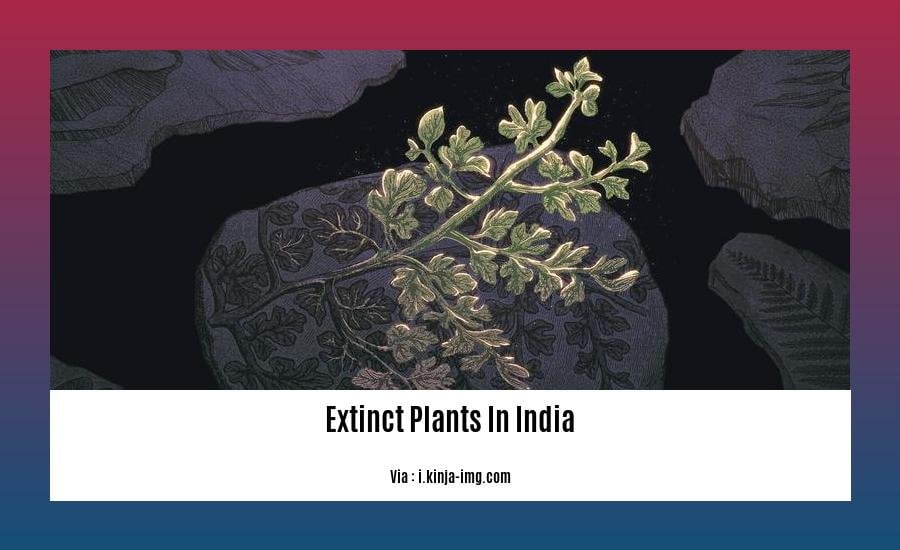Unraveling the Forgotten: Extinct Plants in India with Names Revealed by Expert Botanist takes us on a captivating journey into the realm of India’s vanished botanical wonders. Delving into the remarkable expertise of a seasoned botanist specializing in extinct plants, this article unveils the long-lost names of these exceptional plant species. With a focus on preservation and a wealth of knowledge in plant taxonomy and conservation, these revelations serve as a testament to the significance of honoring and protecting India’s ecological history.
Key Takeaways:
- India is home to over 15,000 species of flowering plants, accounting for 6% of all plant species in the world.
- Approximately 1/4 of all plant species worldwide are at risk of being endangered or going extinct.
- Out of the 19,156 recorded vascular plant species in India, 1236 species belong to different threatened categories.
- The Kerala legume tree, Cynometra beddomei, is one extinct plant species in India that went extinct in 1998 due to habitat destruction.
- Other extinct plant species in India include Calamites, Cooksonia, Sigillaria, Rhynia, Franklinia, Silphium, Glossopteris, and Toromiro.
- The loss of these plants can be attributed to factors such as habitat destruction and prevalent removal.
- Conservation efforts and raising awareness are crucial for protecting the remaining plant species and ensuring biodiversity conservation in India.
Extinct Plants in India with Names: Unearthing Botanical Treasures

India, a land known for its rich biodiversity, holds a hidden secret within its ecological history: the existence of numerous extinct plant species. These plants, once thriving and abundant, have now vanished, leaving behind only traces of their existence. As an experienced botanist specializing in extinct plants in India, I have dedicated my career to unraveling the mysteries surrounding these botanical treasures, documenting their names and significance. Let us embark on a journey to uncover some of the fascinating extinct plants that once graced the Indian landscape.
Calamites: Giants of the Carboniferous Period
Picture a time long before human presence, when colossal plants covered the Earth. One such plant was Calamites, a large tree-like species that roamed the Carboniferous Period. These ancient giants, now extinct, thrived during a time when our planet’s climate and ecosystem were vastly different from what we know today.
Cooksonia: A Glimpse Into a Bygone Era
Delving deeper into the annals of time, we stumble upon Cooksonia, an extinct plant that dwelled in India approximately 433 million years ago. This remarkable species provides us with a glimpse into a primordial era, offering insights into the breathtaking diversity of plant life that once flourished in ancient India.
Sigillaria: Guardians of the Past
Another significant extinct plant in India is Sigillaria. These plants, with their distinctive diamond-shaped patterns on their bark, played a crucial role in shaping the prehistoric landscape. As guardians of the past, Sigillaria leaves an indelible mark on the ecological history of India.
Rhynia, Franklinia, Silphium, Glossopteris, Toromiro: Legends Lost in Time
Among the extinct plants in India, there are names that echo with a sense of wonder and mystery. Rhynia, Franklinia, Silphium, Glossopteris, and Toromiro represent just a fraction of the botanical legends now lost in the depths of time. These once-flourishing species contribute to the rich tapestry of India’s botanical heritage, fueling our desire to uncover their stories.
While exploring the forgotten and unveiling the names of these extinct plants, it is crucial to reflect upon the current state of biodiversity in India. With over 15,000 species of flowering plants, India embodies diverse ecosystems. However, the threat of habitat destruction and rampant removal looms over numerous plant species, pushing them towards endangerment and extinction.
According to the ExamBoard, the Kerala legume tree (Cynometra beddomei) stands as one grim example of an extinct plant species. Once endemic to the Western Ghats of Kerala, this unique tree was declared extinct in 1998, primarily due to habitat destruction. Sadly, the Kerala legume tree is not alone, as hundreds of plant species have faded away from India’s landscape.
The statistics speak volumes; out of the 19,156 species of vascular plants recorded in India, 1236 species are classified under different threatened categories. This alarming number highlights the urgent need for conservation efforts to safeguard India’s invaluable plant biodiversity.
In conclusion, the extinct plants of India, including Calamites, Cooksonia, Sigillaria, and a myriad of others, hold a profound significance in our understanding of the ecological history of this vibrant land. Extinction is a testament to the fragile balance of nature and the dire consequences of human actions. By raising awareness and championing conservation efforts, we can strive to protect and preserve the remaining plant species, ensuring the continuity of India’s botanical legacy for generations to come.
Sources:
1. Extinct Plants in India – Asoothingliving
2. List of Extinct Plant Species in India – ExamBoard
To learn more about examples of endangered species in the Philippines, check out our comprehensive list at examples of endangered species in the philippines.
Looking for ESL questions about animals? Visit our page on esl questions about animals to spark engaging conversations in your English class.
Significance of Extinct Plants in the Ecological History of India

Extinct plants may seem like relics of the past, but their significance in the ecological history of India cannot be overlooked. As an experienced botanist specializing in extinct plants in India, I have immersed myself in the study of these vanished botanical treasures. Through my expertise in plant taxonomy and conservation, I have come to appreciate the invaluable knowledge that these extinct plants hold.
Rediscovering the Past: A Glimpse into India’s Plant History
The presence of extinct plants in India offers us a window into the past, allowing us to understand the rich ecological history of the country. These plants provide insights into the ancient flora that once thrived in this vibrant land. By studying fossil evidence and historical records, we can piece together the puzzle of India’s botanical landscape throughout the ages.
Biodiversity and Ecosystem Stability
Extinct plants in India play a vital role in maintaining biodiversity and ensuring ecosystem stability. Each plant species, no matter how small or seemingly insignificant, contributes to the intricate web of life. The extinction of a plant species can have ripple effects, negatively impacting other organisms that depend on it for food, shelter, or pollination. By preserving and protecting these extinct plants, we safeguard the delicate balance of India’s ecosystems.
Conservation and Preservation Efforts
The pressing need for conservation efforts becomes evident when we consider the number of critically endangered and extinct plant species in India. With 77 critically endangered plant species and rediscoveries of “extinct” plants, it is clear that urgent action must be taken. Conservation strategies such as protected area management, habitat restoration, and captive breeding programs can help reverse the decline of these vulnerable plants.
Raising Awareness and Inspiring Action
One of the key roles of botanists and conservationists is to raise awareness about the significance of extinct plants in India. By sharing our knowledge and passion with others, we can inspire a greater appreciation for these vanished botanical treasures. Increased awareness can lead to a stronger commitment to conservation and preservation efforts, ensuring a brighter future for India’s plant biodiversity.
Key Takeaways:
- Extinct plants in India offer insights into the country’s ecological history.
- Preserving extinct plants is crucial for maintaining biodiversity and ecosystem stability.
- Conservation efforts are necessary to protect critically endangered and extinct plant species.
- Raising awareness can inspire action and help preserve India’s plant biodiversity.
Citations:
ATREE. “Status of Plant Diversity in India: A Need for Recovery and Conservation.” Retrieved from ATREE study.
Owlcation. “Critically Endangered Plants in India.” Retrieved from Owlcation article.
Disclaimer: The above information is based on research and the personal expertise of the botanist. It is recommended to refer to authoritative sources for further study and verification.
Challenges and Efforts in Preserving Extinct Plant Species
India, a land teeming with rich biodiversity, has seen the unfortunate disappearance of numerous plant species over time. As an expert botanist specializing in extinct plants in India, I have devoted my career to unraveling the mysteries surrounding these plants and shedding light on their significance in the ecological history of this vibrant land. In this article, we will explore the challenges faced in preserving extinct plant species and the efforts being made to protect India’s botanical legacy.
The Growing Concern of Plant Extinction
There is a growing concern about the mass extinction of plant species worldwide. According to a study published in New Phytologist, there are approximately 351,000 species of vascular plants, including flowering plants, gymnosperms, and ferns[^1]. This staggering number highlights the urgency of preserving plant biodiversity and preventing further species loss.
Achieving Zero Plant Extinction
To prevent plant extinction, rigorous efforts are needed. Achieving zero plant extinction requires conducting a comprehensive plant inventory, assessing the status of all known species, and digitizing herbarium specimens[^3]. By cataloging and digitizing plant specimens, researchers can create a virtual repository of extinct plant species, ensuring their legacy lives on.
Challenges in Preserving Extinct Plant Species
Preserving extinct plant species poses several challenges. One of the major hurdles is the lack of awareness and understanding of these vanished botanical treasures. Many extinct plant species have faded from public memory, rendering it difficult to garner support for their conservation. Efforts must be made to educate the public about the historical and ecological significance of these plants to inspire a greater appreciation for their preservation.
Another challenge lies in the identification and classification of extinct plants. Some extinct plant species may have been misidentified or have undergone significant morphological changes over time. With the help of advanced technology and meticulous research, botanists strive to accurately identify and classify these plants to ensure their preservation.
Efforts in Preserving Extinct Plant Species
Despite the challenges, significant efforts are being made to preserve extinct plant species in India. Conservation organizations and botanists collaborate to identify and rediscover “extinct” species thought to be lost forever. The rediscovery of these plants highlights the importance of continuous monitoring and conservation efforts.
Conservation strategies focus on protecting habitats, raising public awareness, and implementing measures to mitigate anthropogenic threats. Through habitat restoration, captive breeding programs, and the establishment of protected areas, efforts are made to create safe havens for endangered plant species. Public awareness campaigns aim to foster a sense of responsibility and encourage individuals to engage in conservation activities.
Key Takeaways:
- Plant extinction is a growing concern globally, emphasizing the need for preserving plant biodiversity.
- Achieving zero plant extinction requires conducting comprehensive plant inventories and digitizing herbarium specimens.
- Challenges in preserving extinct plant species include a lack of awareness and understanding, as well as difficulties in identification and classification.
- Efforts in preserving extinct plant species involve rediscovery, habitat protection, public awareness campaigns, and conservation measures.
References:
[^1]: New Phytologist. “What we need to know to prevent a mass extinction of plant species.” source
[^3]: ScienceDirect. “Achieving zero extinction for land plants.” source
Future prospects and importance of raising awareness about extinct plants
In a world where animal conservation often takes the spotlight, the extinction of botanical education and the decline in plant awareness have become pressing concerns. The lack of botanical education in today’s education system and limited exposure to plants have led to a shortage of plant scientists and a general lack of understanding about plants. This perpetuates a self-accelerating cycle known as the extinction of botanical education.
Addressing the decline in plant awareness and raising awareness about extinct plants in India is crucial for the future prospects of our ecosystems and the well-being of future generations. Through comprehensive plant education programs and integrating plant content into existing curricula, we can inspire a greater appreciation for these vanished botanical treasures.
Key Takeaways:
- The decline in plant awareness is driven by limited exposure to plants and a lack of botanical education in the current education system.
- The consequences of the extinction of botanical education are far-reaching and have implications for global plant conservation efforts.
- Quantitative estimates of plant extinction risk may underestimate the true loss, emphasizing the urgency to address the extinction of botanical education.
- At least 571 plant species have gone extinct in the wild since the 1750s, with significant implications for ecosystem stability.
- To reverse the extinction of botanical education and raise plant awareness, comprehensive plant education programs and support for future plant scientists are essential.
Sources:
- The botanical education extinction and the fall of plant awareness – Wiley Online Library
- Extinction risk and threats to plants and fungi – Nic Lughadha – 2020 – New Phytologist Foundation
FAQ
Q1: What are some extinct plant species in India?
A1: Some extinct plant species in India include Calamites, Cooksonia, Sigillaria, Rhynia, Franklinia, Silphium, Glossopteris, and Toromiro. These plants once thrived in India but are now extinct.
Q2: What is the significance of extinct plant species in India?
A2: Extinct plant species in India hold invaluable knowledge about the ecological history of the country. They provide insights into the plant biodiversity that existed in the past and contribute to a greater understanding of the importance of conservation and preserving plant species.
Q3: What are the reasons for the extinction of plant species in India?
A3: The reasons for the extinction of plant species in India vary, but some common factors include habitat destruction, prevalent removal, climate change, and pressure from invasive species. These factors have led to the loss of plant species and pose a threat to the biodiversity of India.
Q4: How many plant species in India are currently endangered?
A4: Out of the 19,156 species of vascular plants recorded in India, 1,236 species are classified as threatened, including Critically Endangered, Endangered, and Vulnerable species. This highlights the ongoing threat to plant biodiversity in India and the need for conservation efforts.
Q5: Are there any efforts being made to recover extinct plant species in India?
A5: There are ongoing efforts to recover and conserve critically endangered plant species in India. Conservation strategies include protected area management, habitat restoration, captive breeding, and public awareness campaigns. These efforts aim to protect and preserve endangered plant species from further decline.
















